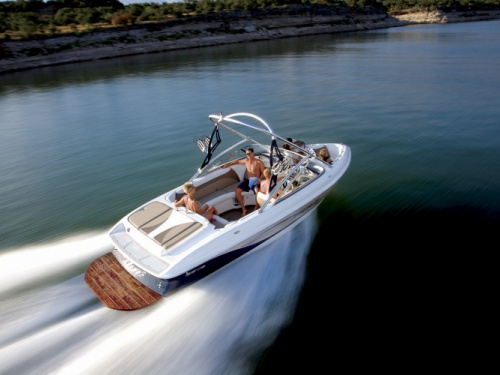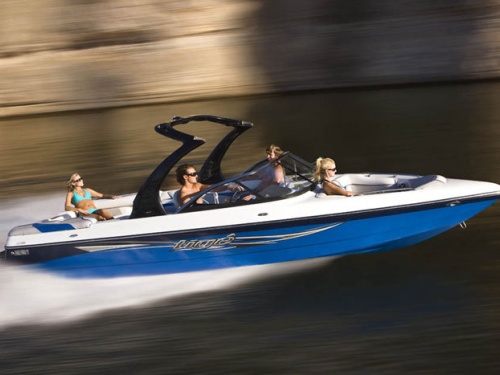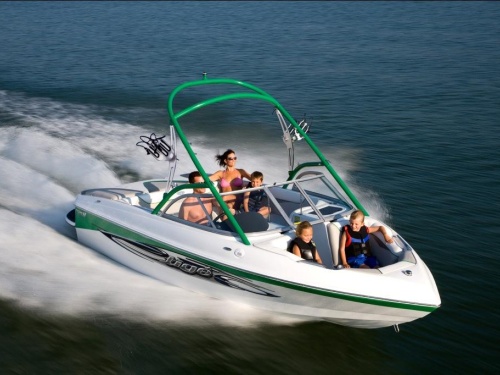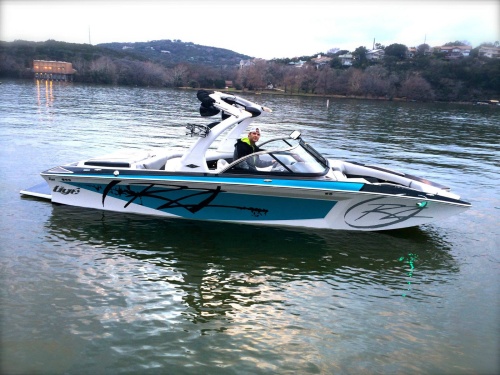Access More Boat Tests
Already have an account? Login
Tigé R20 (2014-)
1 x 350-hp Indmar 5.7 M57
Brief Summary
With the R20, Tigé has created a cost effective boat with the same performance hull of the high end boats in the lineup. It still allows for the capability to dial in the perfect sized wake in a high performance boat that can hold her own right alongside the best of the best. She also solves the problem for those that need a smaller boat due to tow vehicle capacities or lake size limit restrictions. She measures in at 20’ (6.1 m) and has an empty weight just over 3,000 lbs. (1,361 kg).
Key Features
- Lifeplus lifetime replacement limited warranty
- High flex gel coat
- Tige speedset cruise control
- 20 oversized drink holders
- Convex rear-view ski mirror
- Aluminum ski pylon
- Transom activity center with self-draining storage
- Fiberglass non-skid removable/collapsible swim platform
- Wet Sounds premium sound system with 4 speakers
Test Results
| RPM | MPH | Knots | GPH | MPG | NMPG | STAT. MILE | NM | dBa |
|---|---|---|---|---|---|---|---|---|
| 650 | 3.9 | 3.4 | 0.86 | 4.56 | 3.97 | 156 | 136 | 69 |
| 1000 | 5.5 | 4.7 | 1.2 | 4.54 | 3.95 | 155 | 135 | 71 |
| 1500 | 7.1 | 6.2 | 2.25 | 3.16 | 2.74 | 108 | 94 | 75 |
| 2000 | 8.6 | 7.4 | 3.7 | 2.31 | 2.01 | 79 | 69 | 91 |
| 2500 | 13.3 | 11.5 | 5.25 | 2.52 | 2.19 | 86 | 75 | 89 |
| 3000 | 23 | 20 | 6.7 | 3.43 | 2.99 | 117 | 102 | 93 |
| 3500 | 27.8 | 24.2 | 8.1 | 3.43 | 2.98 | 117 | 102 | 92 |
| 4000 | 32.5 | 28.2 | 11.2 | 2.9 | 2.52 | 99 | 86 | 94 |
| 4500 | 36.6 | 31.8 | 14.25 | 2.57 | 2.23 | 88 | 76 | 95 |
| 5000 | 39.9 | 34.7 | 18.4 | 2.17 | 1.89 | 74 | 64 | 99 |
| 5300 | 41.7 | 36.2 | 22.3 | 1.87 | 1.62 | 64 | 56 | 99 |
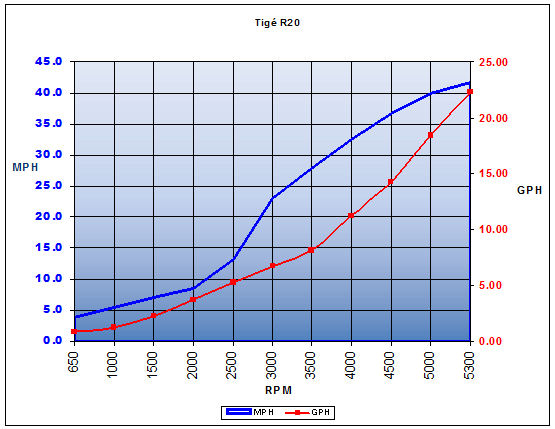
Specifications
| Length Overall | 20' / 6.10 m |
|---|---|
| Beam |
94'' 2.38 m |
| Dry Weight |
3,075 lbs. 1,394.79 kg |
| Tested Weight |
3,666 lbs. 1,663 kg |
| Draft | N/A |
| Deadrise/Transom | N/A |
| Max Headroom | Open |
| Bridge Clearance | N/A |
| Fuel Capacity |
38 gal. 143.85 L |
| Water Capacity | N/A |
| Total Weight |
3,666 lbs. 1,663 kg |
Acceleration Times & Conditions
| Time to Plane | 2.1 sec. |
|---|---|
| 0 to 30 | 6.6 sec. |
| Ratio | N/A |
| Props | N/A |
| Load | 2 persons, 3/4 fuel, no water, 50 lbs of gear |
| Climate | 78 deg., 68 humid.; wind: 5-10 mph; seas: light chop |
Engine Options
| Tested Engine |
1 x 350-hp Indmar 5.7 M57 |
|---|---|
| Std. Power |
1 x 335-hp Indmar 5.7L DC Fusion57 |
| Opt. Power |
1 x 415-hp Indmar 6.0L L96 M60 1 x 350-hp Indmar 5.7L Premium M57 |
Captain's Report
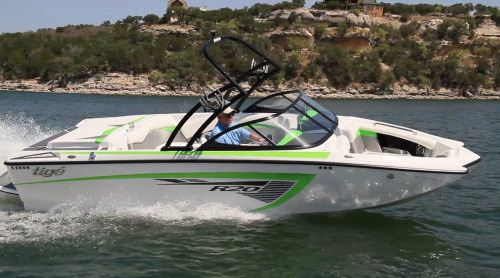
Mission Statement
The Tigé R20 was designed to provide an entry level wakeboat that still maintains the company’s demand for performance and construction quality. The price is kept down by eliminating high end upgrades and options while ensuring that the ride quality is not sacrificed.
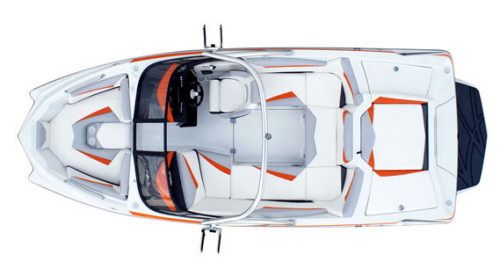
Differentiating Features
•
Inboard Engine.
True wakeboats are able to get a better wake, with a better table between the wakes, with inboard propulsion. Tigé will not compromise on this so the R20 makes a good transitional boat to inboard power.
•
Engine in Stern.
Other wakeboats mount the engine in the middle of the boat, creating a huge engine box right in the center of the cockpit. It’s in the way, it’s ugly, and it’s not necessary. With a V-drive transmission, Tigé is able to move the engine to the stern, where it belongs.
•
Pickle-fork Bow.
This allows Tigé to carry most of the R20's beam fully forward providing more room in the bow.
•
Deckadence Mat.
Rather than put a regular snap-in carpet as an option in the R20, Tigé went with the optional Deckadence mat which is made from a synthetic material that drains water better and promotes faster evaporation. This is an important feature when dealing with a boat made specifically for watersports. At one point or another nearly all of the occupants will be coming back on board wet.
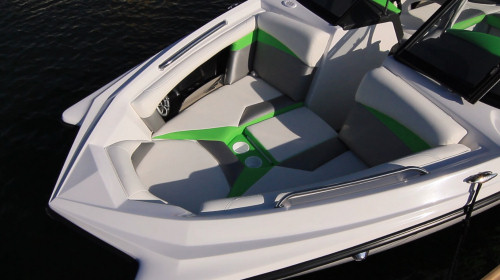
Build Quality Remains
Tigé uses the same build quality, same Convex V hull, and same performance ride, and includes every needed to tow to perfection, her mission is to keep the price down. It does this by keeping a check on some of the more expensive equipment, that while making life easier, adds little to the ability to get the job done.
Simple is as Simple Does
Case in point is the tower. Tigé’s Vector tower provides everything needed to accompany a great tow boat, and does it without adding items like LED courtesy lights, embedded docking lights, or ratcheting board racks. It does however, include the fixed racks and it’s still collapsible for easy storing in the garage.

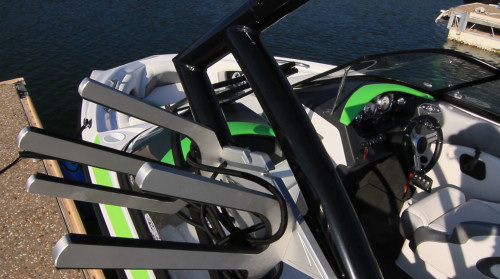
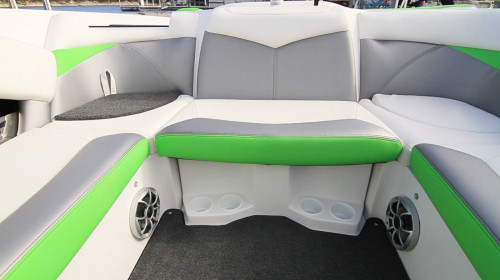
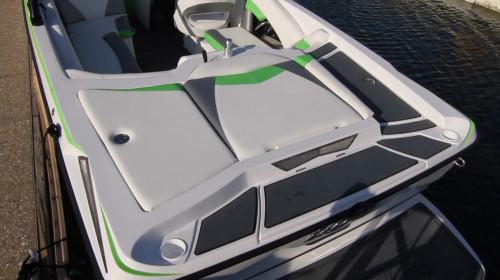
Helm
The helm panel utilizes a Speedset controller to maintain, and make incremental corrections to, the tow speed. It’s mounted to the right side of the helm just above the stereo remote. A soft touch upholstered dash keeps glare down and it’s sewn with UV resistant Gore Tenera thread.
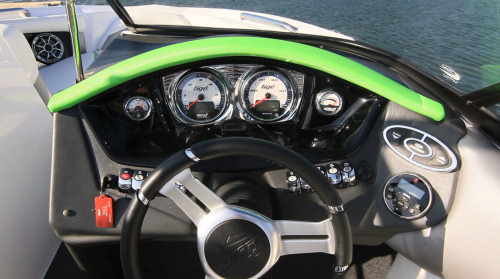
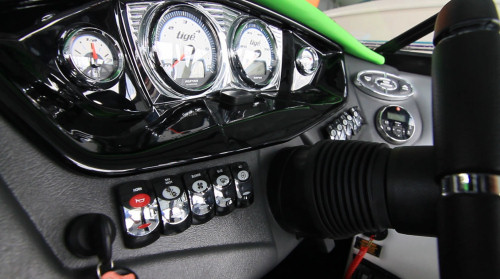
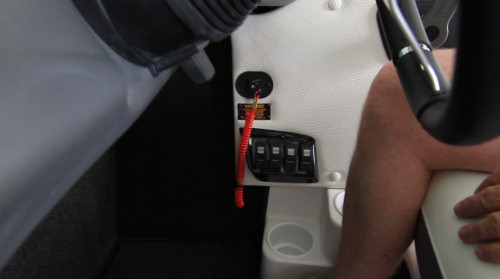
The swim platforms on all Tigé boats are large and mounted low to the water. This eliminates the need for reboarding ladders, and it also makes it that much easier to get into the water with boards attached.
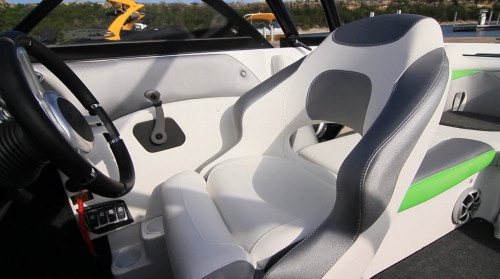
Keeping the Beef
First and foremost, Tigé's mission in life is to produce premium wake boats. It is here that Tigé excels, although its boats are also equally as good for skiing and, in the case of the R20, a good all-around sportboat for the family. In order to remain competitive, and make no mistake, these boats are competitive, Tigé has come up with a triple whammy for creating the wake that everyone craves.
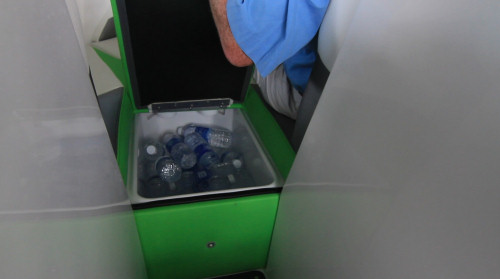
First -- The Hull Shape:
Tigé has reconfigured the traditional skiboat hull (that produces a flat wake) into one designed to help create, and perfectly form, the wake. The hull design is called Convex V. Where other wakeboats have bottoms that run in a straight line until they get to the stern and then hook down, Tigé’s actually curves slightly upward. That drops the transom down, and the more of the transom in the water, the more wake the boat creates.
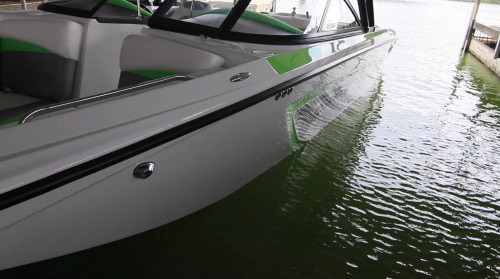
Second -- Plenty of Ballast:
The deeper the hull is in the water the more water it will displace and the bigger the wake will be. Ballast bags are a tried and true method of adding weight, sinking the boat lower in the water, and increasing wake. Tigé’s R20 has dual ballast sacks in the stern and a horseshoe shaped one at the bow that add a total of 900 lbs. (408 kg) to the boat. Optional ballast sacs can be added to bring the total weight to 1.600 lbs. (726 kg).
Third -- The Wake Tab:
Tigé calls this tab TAPS2. TAPS stands for Tigé Adjustable Performance System, and it’s patented to work along with the Convex V hull design. TAPS2 is a trim plate affixed to the aft end of the hull, so operators can adjust the parameters from the helm in ways that were previously unavailable. Want a bigger wake? Adjust the TAPS2 plane up and you have a fatter wake. Want to take some curl out of the wake? Bring the TAPS2 plate down and you tame the beast a bit.
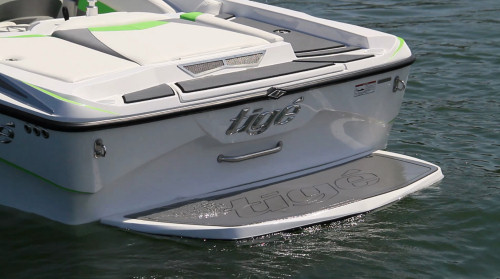
Handling
Our test revealed that this boat handled as well as the high-end Tigé boats, and that means that the hull was just as solid, with no flex, and the performance additions of the Convex V-hull remained intact.
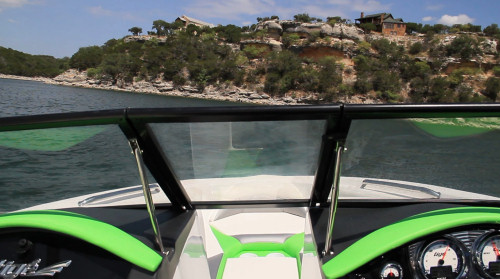
Also, as with the rest of the line, I found that the TAPS2 system is most effective as a fine-tuning device for the wake when the ballast tanks are full. At the high end of the speed range, I did notice that there was a bit of a bow porpoising, but that was easily stabilized by bringing the TAPS2 plate down and planting more of the forefoot on the water. This is a factor of the Convex V-hull, which by design is to tune the wake, so along with the use of TAPS2, the driver can also stabilize the cruise attitude.
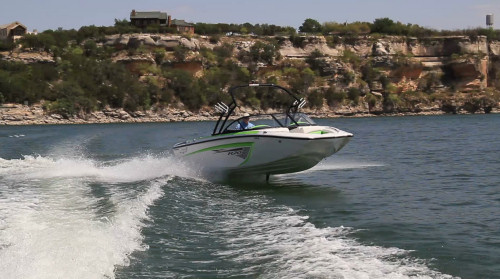
She turns like she’s on rails, and bleeds off speed during the turns so don’t hesitate to add power, or let Speedset handle the chore. If power is reduced just before entering the turns, she can be made to fishtail around to quickly reverse course.
By the Numbers
The Tigé R20 has a LOA of 20’ (6.1 m) and a beam of 94” (239 cm). With an empty weight of 3,075 lbs., 28 gallons (106 L) of fuel and 2 people onboard, we had an estimated test weight of 3,666 lbs. (1,663 kg).
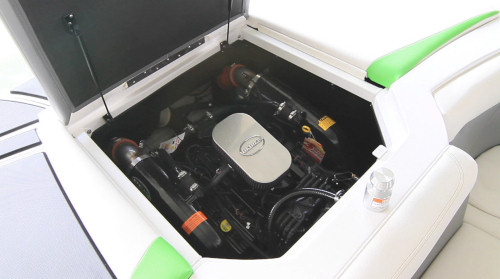
With the 350-hp 5.7L Indmar M57 powering our test boat, we reached a top speed at 5300 rpm and 41.7 mph. At that speed the R20 was burning 22.3 gph which translates into a range of 64 miles. Pulled back to a more economic cruise setting of 3500 rpm and the R20 was running at 27.8 mph with only an 8.1 gph fuel burn. That extended the range to 117 miles and the R20 could keep that speed up for 4 hours and 12 minutes while still maintaining a 10% reserve.
Time to plane was only 2.1 seconds which is remarkably fast. We reached 20 mph in 4.2 seconds, and accelerated through 30 mph in 6.6 seconds.
Observations
Although Tigé has a broad offering of wakeboats that can take a wakeboarder/surfer to the professional level, not all of us are able to get to that level. Sometimes weekends on the water are all that matter, and as such, spending top dollar for every bell and whistle is not part of the equation.
Our test has shown that the Tigé trademark performance is still there with the R20. The size of the wake is the same as with other Tigé models of the same specifications. The hull, deck, stringers and other substructures are the same. Frankly, all that’s missing is a higher price tag that those added accessories command. And that means everyone wins.

